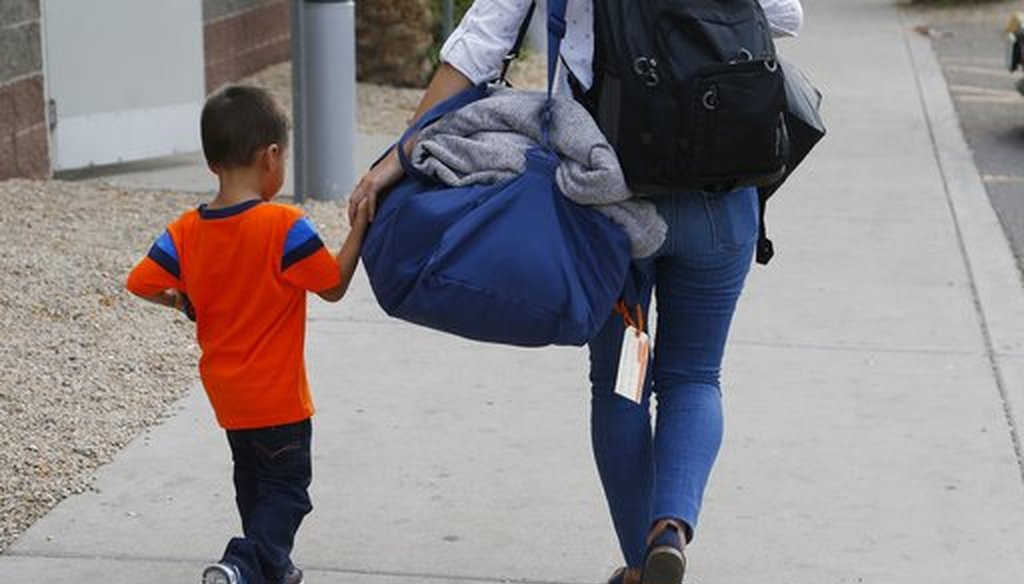Stand up for the facts!
Our only agenda is to publish the truth so you can be an informed participant in democracy.
We need your help.
I would like to contribute

Three-year-old Jose Jr., from Honduras, is helped by representative of the Southern Poverty Law Center as he is reunited with his father Tuesday, July 10, 2018, in Phoenix. (AP Photo/Ross D. Franklin)
The Trump administration’s process for reuniting immigrant families separated at the border hasn’t been easy.
Pressured by a court order, officials have been working overtime to reconnect parents and children separated this summer as a result of the administration’s "zero-tolerance" policy. A federal judge ordered the administration to reunify children under 5 years old with their parents by July 10 (a deadline it missed) and the remaining children by July 26.
There is still a long way to go. The vast majority of kids remain separated.
In a hurry? See our timeline at the bottom
The government has cited logistical issues in getting some of them back together (one being that some parents were already deported). Official data remains limited and inconsistent.
Sign up for PolitiFact texts
PolitiFact decided to take a closer look at the issue to lay out what’s known and what remains uncertain about the process.
The separations stem from Trump’s "zero-tolerance" policy calling for the prosecution of all immigrants who illegally crossed into the United States at the southwest border. Attorney General Jeff Sessions officially announced the policy April 6 as a deterrent to illegal immigration.
At least 2,342 children were separated from the adults they were traveling with between May 5 and June 9, officials have said.
But by July 6, the U.S. Health and Human Services Department gave a more vague figure of "under 3,000" children in its custody, which could include children separated at the border before May 6.
The number also included children who were separated for other reasons, such as safety concerns, and children who "could have been separated from a parent prior to crossing the U.S. border."
The government missed a deadline set by a federal judge to reunite all children under 5 years old with their parents by July 10. The judge ordered children 5 and older to be reunited by July 26.
As of July 12, government-provided reunification data said 103 children under 5 years old were covered by the court order. Of those, 57 were reunified and 46 were ineligible for reunification.
The administration said it could not return about half of those 46 children to their parents due to safety concerns. The remaining children’s parents had been deported or were in custody for other reasons. In one instance, the location of a parent had "been unknown for over a year." The human services department on July 10 said records showed the parent and child "might be U.S. citizens."
On June 23, DHS said it had reunited at least 522 children who had been in its custody and not yet transferred to HHS. Since their parents’ criminal proceedings happened quickly, the children and parents were reunited and transferred together to the custody of U.S. Immigration and Customs Enforcement, DHS said.
HHS said it is using a contractor to perform DNA testing "only when there is a specific purported parent-child relationship that needs to be validated."
The Daily Beast reported that a handful of women had been told by government officials that they had to pay for DNA testing in order to be reunited with their children. The government disputed that, saying it provides DNA testing at no cost to verify parentage.
There have been numerous reports of families separated even when they showed up — legally — at ports of entries to ask for asylum.
CBP rebuked those claims, saying July 9 that family separations at ports of entries are "very rare, and it’s only done under exigent circumstances in order to protect the child and to ensure the wellbeing of the child."
The Trump administration has emphasized that immigrants who want to claim asylum should do so at ports of entry instead of trying to come in illegally. Under U.S. law, immigrants can request the protection whether they came in legally or illegally.
ICE has started releasing families into the United States, with parents wearing a GPS ankle monitor. They are expected to appear in immigration court.
ICE decided to use Alternatives to Detention, which includes the ankle monitor, for most cases involving children under 5 years old, an ICE official told PolitiFact. Reviews of cases involving children 5 to 17 years old are being done on a case-by-case basis.
In a June 20 executive order to stop family separations, President Donald Trump directed Sessions to file a request with a federal court in California to modify the 1997 Flores settlement and allow the detention of families throughout their immigration proceedings. Federal courts have interpreted the agreement as limiting children detention to no more than 20 days.
On July 9, a federal judge rejected the government’s settlement modification request. Another federal judge is considering a government motion to let parents choose between staying with their children in long-term ICE detention or voluntarily giving their children to HHS while they await legal proceedings, the New York Times reported.
There’s been mixed messaging about this from administration officials. Trump’s executive order did not say the policy to prosecute immigrants for illegal entry was over.
Sessions on June 25 said they would continue to prosecute adults who enter the United States illegally. But on that same day, CBP Commissioner Kevin K. McAleenan said his agency had temporarily stopped referring adults traveling with children for prosecution.
We asked the Justice Department and the Department of Homeland Security for clarification but did not heard back.
Our Sources
Listed in the story.




































